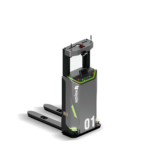An Automated Storage and Retrieval System (ASRS) is a material handling system that utilises computer software and automation to store and retrieve materials from a designated storage area. ASRS systems are commonly used in warehouses and distribution centres to improve efficiency and productivity. They can be used to store a wide variety of materials, including pallets, boxes, totes, and smaller items.
Benefits of ASRS
- Improved efficiency and productivity:
ASRS systems can significantly improve the efficiency and productivity of warehouse and distribution centre operations. By automating the storage and retrieval of materials, ASRS systems can reduce labor costs, increase throughput, and improve accuracy. - Reduced space requirements:
ASRS systems can help reduce the amount of space required for storage. By storing materials in high-density racks, ASRS systems can maximise the use of available space. - Improved inventory control:
ASRS systems can help improve inventory control by providing real-time tracking of inventory levels. This information can be used to optimise inventory management and reduce stockouts. - Enhanced safety:
ASRS systems can help enhance safety by reducing the need for manual handling of materials. This reduces the risk of accidents and injuries.
Types of ASRS
There are several different types of ASRS, including:
- Unit load ASRS:
Unit load ASRS systems are designed to store and retrieve palletised or unitised loads. These systems are typically used in warehouses and distribution centres that handle large volumes of materials. - Mini-load ASRS:
Mini-load ASRS systems are designed to store and retrieve smaller items, such as boxes and totes. These systems are typically used in warehouses and distribution centres that handle a variety of different types of materials. - Shuttle ASRS:
Shuttle ASRS systems are a type of unit-load ASRS that utilises shuttles to move pallets between storage racks and retrieval points. These systems are typically used in warehouses and distribution centres that have high throughput requirements.
Components of an ASRS
An ASRS typically consists of the following components:
- Storage racks:
Storage racks are used to store the materials. The type of storage racks used depends on the type of ASRS and the materials being stored. - Retrieval and storage machines (RSMs):
RSMs are the machines that move materials between the storage racks and retrieval points. The type of RSMs used depends on the type of ASRS. - Computer software:
Computer software is used to control the ASRS. The software monitors the movement of materials, tracks inventory levels, and optimises system performance.
Applications of ASRS
ASRS systems are used in a wide variety of industries, including:
1. Manufacturing:
ASRS systems are used in manufacturing facilities to store and retrieve raw materials, work-in-progress inventory, and finished goods.
2. Retail:
ASRS systems are used in retail warehouses and distribution centres to store and retrieve products.
3. Food and beverage:
ASRS systems are used in food and beverage processing and distribution facilities to store and retrieve raw materials, ingredients, and finished products.
4. Pharmaceutical:
ASRS systems are used in pharmaceutical manufacturing and distribution facilities to store and retrieve sensitive materials.
The future of ASRS
The future of ASRS is bright. As technology continues to advance, ASRS systems will become even more efficient, productive, and versatile. ASRS systems will also play an increasingly important role in the development of smart warehouses and factories.
Empower your logistics with SmartlogitecX, fueled by WayZim Technologies. As leaders in Warehouse Automation for the Australian market, we’re dedicated to delivering efficiency and innovation right to your doorstep. SmartlogitecX’s approach is two-fold: globally informed, locally applied. Take the first step towards optimised operations by reaching out to our sales team for a solution that speaks directly to your needs.


